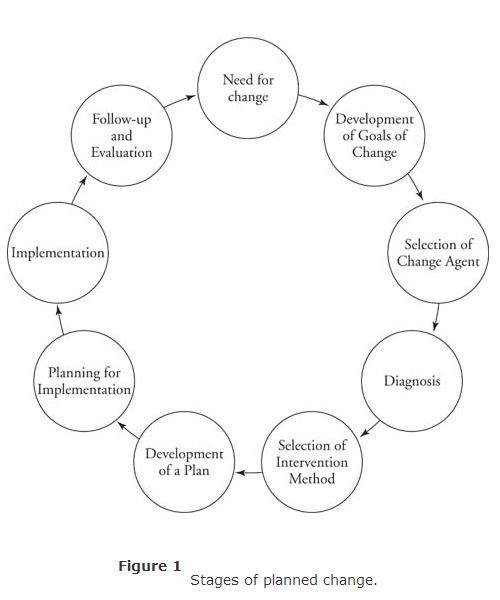Once managers and an organization commit to planned change, they need to create a logical step‐by step approach in order to accomplish the objectives. Planned change requires managers to follow an eight‐step process for successful implementations, which is illustrated in Figure 1.

- Recognize the need for change. Recognition of the need for change may occur at the top management level or in peripheral parts of the organization. The change may be due to either internal or external forces.
- Develop the goals of the change. Remember that before any action is taken, it is necessary to determine why the change is necessary. Both problems and opportunities must be evaluated. Then it is important to define the needed changes in terms of products, technology, structure, and culture.
- Select a change agent. The change agent is the person who takes leadership responsibility to implement planned change. The change agent must be alert to things that need revamping, open to good ideas, and supportive of the implementation of those ideas into actual practice.
- Diagnose the current climate. In this step, the change agent sets about gathering data about the climate of the organization in order to help employees prepare for change. Preparing people for change requires direct and forceful feedback about the negatives of the present situation, as compared to the desired future state, and sensitizing people to the forces of change that exist in their environment.
- Select an implementation method. This step requires a decision on the best way to bring about the change. Managers can make themselves more sensitive to pressures for change by using networks of people and organizations with different perspectives and views, visiting other organizations exposed to new ideas, and using external standards of performance, such as competitor's progress.
- Develop a plan. This step involves actually putting together the plan, or the “what” information. This phase also determines the when, where, and how of the plan. The plan is like a road map. It notes specific events and activities that must be timed and integrated to produce the change. It also delegates responsibility for each of the goals and objectives.
- Implement the plan. After all the questions have been answered, the plan is put into operation. Once a change has begun, initial excitement can dissipate in the face of everyday problems. Managers can maintain the momentum for change by providing resources, developing new competencies and skills, reinforcing new behaviors, and building a support system for those initiating the change.
- Follow the plan and evaluate it. During this step, managers must compare the actual results to the goals established in Step 4. It is important to determine whether the goals were met; a complete follow‐up and evaluation of the results aids this determination. Change should produce positive results and not be undertaken for its own sake.
Keep in mind that a comprehensive model of planned change includes a set of activities that managers must engage in to manage the change process effectively. They must recognize the need for change, motivate change, create a vision, develop political support, manage the transition, and sustain momentum during the change.